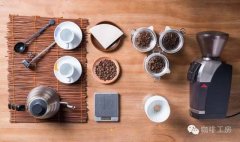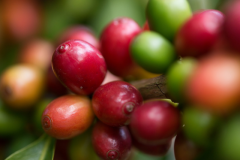What is the old Manning, his area of origin?
aged mantinine
Indonesia is the world's largest archipelago,
Arabica coffee was introduced during Dutch colonization in the 18th century
Until modern times, it has become one of the top five coffee producers in the world
The main producing areas are located in Sumatra, Java and Sulawesi three islands.
The northern part of Sumatra is relatively high above sea level
Aceh Province, where Lake Tawar is located, and North Sumatra, where Lake Toba is located
(Lindong is located in this province) Two major Arabica coffee producing areas.
Lake Tawa is located in the Gayo mountains north of Aceh in Sumatra.
Indonesia, straddling the equator, has a humid tropical rainforest climate with abundant rainfall.
Fertile volcanic loam brings rich nutrients to coffee;
However, due to its remote location and inconvenient transportation,
Coffee wasn't grown until 1924,
Most of them adopt traditional shade and organic cultivation without pesticide application.
local humid climate, beans with shell after preliminary washing, fermentation treatment,
After one or two days of exposure,
Although the moisture content of raw beans is still 30%~50%,
That is, seed husks are removed first and then dried to shorten the drying time of green beans.
After about 2 days of drying, the moisture content of green coffee beans can be reduced to 12 - 13%.
Indonesia's unique semi-washing process, locally known as Giling Basah,
Also known as wet-hulled division.
Sumatra Arabica coffee, commonly known as mantinin,
This name comes from the ancient indigenous people in the area.
Rumor has it that the Japanese occupied Sumatra in the 1940s,
A soldier marvels at the coffee he drinks locally in North Sumatra
Ask them what kind of coffee they have.
But because the language barrier, the other side misunderstood to ask him who he is also,
And answer to the Mandenin, to whom he belongs,
And then when it came out, it was pronounced mantenin by mistake,
Sumatra coffee is synonymous with soil, climate and bean nature. At present, the highest success rate and best quality of aged beans are in Indonesia and India. Indonesian aged beans, best known as mantenin and java old brown, are prepared by drying the pods, and when the moisture content reaches a certain level, the pods are not scraped off to protect the beans, and then stored. The humidity and temperature of the warehouse have certain operation standards, and the pods in the sack should be regularly turned over to avoid falling humidity or mildew and scrap. Aged beans take at least two to three years to mature, called kung fu beans. Aged beans have a tan or dark brown color and a sweet taste. They can be used as a single or espresso coffee. The aged mantinin is a unique mantinin produced by special and complicated treatment of the fresh gold mantinin and special preservation for more than 5 years. As with gold mantinin, the annual yield is limited. Due to the high difficulty and complexity of handling and preservation, the yield of aged beans is smaller, and the treasure is visible. This kind of aged coffee actually has a long history in Indonesia, because early shipping is not so developed, it takes quite a long time to transport coffee from Indonesia to other countries. Over time, the fresh coffee beans rich in moisture slowly dry and the sea breeze blows to add a quite special flavor!~ Because modern shipping advances have greatly reduced shipping times, coffee flavors like this have become a specialty coffee bean. Processing old beans is a technology that must be closely monitored during the aging process of coffee beans. There are standard requirements for humidity and temperature in the warehouse, and the pods in the sacks should be turned from time to time to avoid falling humidity or mildew. Instead of losing its flavor, create another flavor, and a pleasant flavor! Therefore, beans can also be called "kung fu" beans. For more professional coffee exchanges, please scan the code to follow WeChat: FrontStreetCoffee

Important Notice :
前街咖啡 FrontStreet Coffee has moved to new addredd:
FrontStreet Coffee Address: 315,Donghua East Road,GuangZhou
Tel:020 38364473
- Prev

What are the producing areas of Panamanian coffee? What's the flavor of Panamanian coffee?
Professional coffee knowledge exchange more coffee bean information Please follow the coffee workshop (Wechat official account cafe_style) Coffee History of Panama in 1780, after the Europeans first introduced the first Typica tree species to Panama, the road to the history of Panamanian coffee has begun ever since. For Panamanians at that time, such drinks were both novel and mysterious, not only quickly
- Next

The Origin, characteristics and long-standing Market trend of Mocha in Yemen
Professional coffee knowledge exchange more coffee bean information please follow the coffee workshop (Wechat official account cafe_style) Yemen, the hometown of mocha coffee, Yemen is the first country in the world to produce coffee on a large scale as a crop. The Yemeni mocha coffee has distinctive taste characteristics, special taste and varied levels, it has a strong sour taste, it is the kind of pleasant fruit acidity, and
Related
- Detailed explanation of Jadeite planting Land in Panamanian Jadeite Manor introduction to the grading system of Jadeite competitive bidding, Red bid, Green bid and Rose Summer
- Story of Coffee planting in Brenka region of Costa Rica Stonehenge Manor anaerobic heavy honey treatment of flavor mouth
- What's on the barrel of Blue Mountain Coffee beans?
- Can American coffee also pull flowers? How to use hot American style to pull out a good-looking pattern?
- Can you make a cold extract with coffee beans? What is the right proportion for cold-extracted coffee formula?
- Indonesian PWN Gold Mandrine Coffee Origin Features Flavor How to Chong? Mandolin coffee is American.
- A brief introduction to the flavor characteristics of Brazilian yellow bourbon coffee beans
- What is the effect of different water quality on the flavor of cold-extracted coffee? What kind of water is best for brewing coffee?
- Why do you think of Rose Summer whenever you mention Panamanian coffee?
- Introduction to the characteristics of authentic blue mountain coffee bean producing areas? What is the CIB Coffee Authority in Jamaica?

